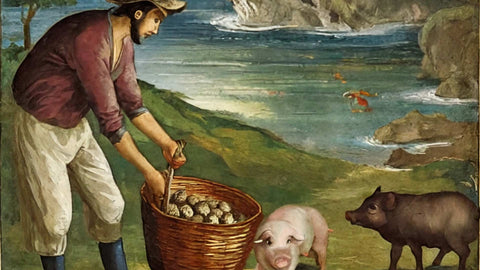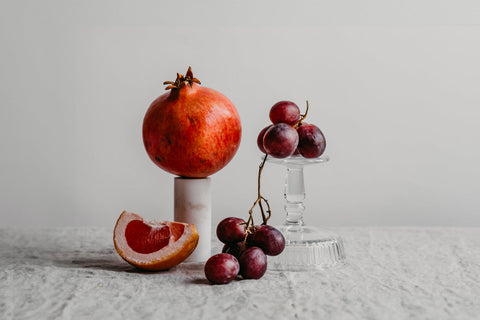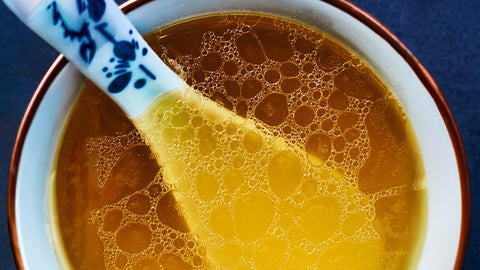In the southwest of France is an area called Périgord—home to the black truffle, one of the most-prized culinary delicacies in the world. Every year, thousands of tourists flock to the region during truffle-hunting season, which begins in the winter when the mushrooms are at their ripest and give off the strongest aroma. The hunt for these famed “black diamonds” has never been easy. For centuries, truffles were coveted by aristocrats and dignitaries for their perfumed, earthy flavor, but were a rarity. The mushrooms only grew underground and in the wild, and could only be found with the help of 400-pound pigs or specially trained dogs.
The Greeks likened finding a truffle to receiving a gift of lightning from the gods. Legend has it that a farmer chanced upon his pig devouring mysterious black growths that had appeared on the roots of a tree. The farmer noticed that the pig’s health improved, so he decided to try the truffles himself. Afterwards, he and his wife, who had not been able to conceive before, were blessed with thirteen children. The Roman poet Juvenal wrote that it was the god Jupiter who had sent the lightning bolt. Known for his prolific sex drive, it was said that the mushrooms held similar aphrodisiac qualities. In a sense this is true, at least for the female pigs that hunt for truffles. The musky aroma of the mushrooms is said to be like the pheromones emitted by a male pig’s reproductive organs.
During medieval times, the truffle was condemned as “witches’ fare”, with church leaders preaching that the exotic fungi came from the devil. The cult food staple was mostly forgotten until the Renaissance, when it began to make its reappearance at the royal banquets of Queen Caterina de Medici and Lucrezia Borgia in the 1500s. Truffle-hunting became a popular form of entertainment among European royals, nobility, and elites. These types of gatherings, where participants would compete to find the most truffles, were popular especially in Italy, where the Piedmont white truffle, the rarest of all truffles, could be found.
Truffles are highly valued not only because they are hard to find, but because for years, nobody knew how to successfully farm them. Champions of the elusive fungi, such as Louis XIV and Prussian biologist Albert Bernhard Frank had attempted but failed to grow them domestically. Human beings had been growing wheat for centuries, but the methods behind truffle-growing were only discovered 200 years ago.
The beginnings of truffle cultivation can be traced to a Frenchman named Joseph Talon. From Périgord, he owned a pig with a knack for unearthing truffles every, single day. He noticed that the growing sites of these mushrooms always seemed to be located near oak trees. He created seedlings from acorns he harvested from these oak trees and planted them across his land. At first, nothing happened, but Talon persevered. After eight years, he was able to harvest his first successful batch of truffles from his oak orchard. Joseph Talon became a rich man, and others began to follow suit, planting hundreds of oak trees from 1870 to 1875. This ushered in a golden age of truffle-growing, especially in France, where an estimated 675 tons of truffles were produced in one year.

Unfortunately, many of these oak orchards and the rural lands they grew in were destroyed during World War I, and production of the mushrooms never recovered. Today, the average yield of truffles in France, from both wild and cultivated sources, is around 8 to 35 tons annually. Spain, the world’s leading producer of truffles, only makes about 47 tons of truffles per year. The relationship between truffles and their host trees is complicated and can take years to develop. Trees must mature at least five years before the fungus spores begin to attach to their roots. Once the mushrooms grow, they help the trees by allowing the roots to absorb minerals from the surrounding soil. The mushrooms, in turn, receive nutrients from the trees’ roots. This symbiotic relationship is called mycorrhiza, and can occur in the living roots of oak, hazel, beech, and poplar trees.
Not all trees will produce truffles, though. Even with the knowledge of growing methods today, truffle cultivation remains challenging. Truffles are extremely sensitive and can only grow in areas with a moderate climate. The amount of rainfall and the pH level of the soil need to be just right. In addition, black truffles can only grow in soil with a high limestone content, while white truffles need to grow in sandy soil. Because of this, it’s becoming more difficult to find truffles in the wild, especially as global warming changes the weather conditions in regions where they are traditionally grown.
Truffles are highly valued not only because they are hard to find, but because for years, nobody knew how to successfully farm them.
Today, methods of artificial mycorrhization are being used to restore truffles in places where they used to grow naturally. As truffles are found in the wild less and less, it seems it will not be possible for the species to survive without human intervention. It used to be that truffles were only grown in Europe, but now companies are experimenting with planting them in new continents such as North America, South America, and Australia.
Truffles continue to have a legendary reputation and are celebrated by chefs, foodies, and connoisseurs all around the world. The two most sought-after species of truffles, France’s black Périgord truffle and Italy’s white Alba truffle, can fetch prices of over a thousand dollars per pound, while the most expensive truffle was a 3-lb white truffle that sold for 330,000 dollars. They add an incomparable, luxuriously nutty flavor to pastas, soups, omelets, and so much more.
Truly, it can be said that truffles are worth the hunt.





